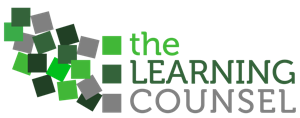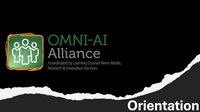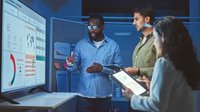While at ISTE, Learning Counsel News Media’s LeiLani Cauthen attended a press briefing by the ISTE/ASCD organization and also Dr. Jeremy Owoh, new President of ISTE, private reception (8:02 of the video.)
During the press briefing we asked Dr. Joseph South, the Chief Innovation Officer of ISTE about where the market is going because we’ve done a lot of research and mathematical modeling and the data is showing massive student losses, absenteeism and a number of other issues. We mentioned how Omni-AI, the administrative application of several types of AI’s converging to be the “mind of the enterprise” is incoming. We asked what are your thoughts about structural shift in the traditional factory model? (Of course we did, we coordinate the Omni-AI Alliance.)
Dr. South: “So I'm really glad that you're asking this. There's really two factors going on here, right? One is the technology factor, which is currently manifest in AI, right? Which is, you know, (what you’d) expect because it's (all been) point solutions, right? The other is the pedagogy that's going on in schools.
So there's technology here and there's pedagogy (there). If the technology conversation is always over here and the pedagogy conversation is always over (there), then this is what we don't understand: we will use AI to support factory models, just like we use tablets to report support factory models, just like we use film strips to support factory models, right? The technology doesn't change (anything.) The teaching model pedagogy changes the teaching model, and this is exactly why ASCD and ISTE merged, is to make those two conversations, one conversation. So what we're really focused on here, and the that we released and that this whole conference is drenched in, is the transformational learning principles.
Right now, it's much easier and more exciting to talk about AI than it is to talk about transformational learning unless you're us, and we are just as excited about transformational learning <laugh>. But those principles, you know, we release those with the same excitement and vigor and energy as we do any of our AI stuff, because it's only by transforming how we teach that we will use the tools the right way. And so you have to take the transformational learning principles and use them to think about how you're using AI. If you do that, you'll use AI in the right places and not in the wrong places. Right? And, you know, we've always been the grownup in the room. We've always said this is the right time to use PBL, this is the wrong time to use PBL. This is the right time to use AI, this is the wrong time to use AI. And we have to know that there are wrong times to use AI, and there are right times. And, and if we're not guided by something like the transformational learning principles, we will lose our way. We will reinforce the factory model with the most cutting edge technology you can possibly think of. We can still put it on students in ways that puts them in a passive mode where they don't learn the next generation skills that they need.”
Learning Counsel:
“What are your thoughts then on moving past Generative AI into like, Time AI, the other discriminative models, the agentic models, the emotional AI you know, theory of mind, to rearrange the factory model so that teaching is only the performative moment? All studies done in homerooms like an airport, flight boards put the kids at the right moment only into (classes with) cohorts that are all at the same moment, no mixed ability teaching…so you still have live teaching, but it's all pace based. So every learning moment is an enrollment moment.”
Dr. South: “Our response to that would be that learning is fundamentally relational. You cannot, you cannot remove relationships from learning.”
Learning Counsel: “Yeah. This still has live teaching.”
Dr. South: “Well, I’m not gonna critique whatever specific model you're talking about, I'm just letting you know the principles that, that we follow. So learning, it's fundamentally relational. And if you're using technology to build and support and expand learning relationships, yeah? You are using it the right way. And if using, you're using technology to isolate a student with a computer and the computer's gonna be like the all-knowing, you know, learning God, um, and fill their brain with stuff, you are using it the wrong way.”
Learning Counsel: “Yeah, I would agree. What I'm thinking with is how do you make it so that we can manage the massive teacher shortage, the attrition, 100% personalization, and really move it so that you're using teachers for the best of their human ability rather than just (put) more tools?”
Dr. South: “That's exactly (what we are thinking.) I think you and I are on the same page, right? Yeah.”
Learning Counsel: “Yeah. So that was my real question is really where is the direction of structure and starting that conversation within your organization to look at what's different in structure because of AI, you know, so I'd like to have you think with, you know, where that's all going?”
Dr. South: “Sure. And, and I think, so one thing I'll just say, and, and unfortunately you missed part of our earlier part of the event, we are right now convening communities of practice of education leaders, coaches, classroom teachers, principals, the whole gamut to work through these issues. And out of that, we expect exemplars to come of actual practice. I feel like it's easy to talk in theoretical terms about things, but unless you're actually working directly with the educators, then you're not gonna get there. And we are doing that. And so I think we'll have more to say on some of these specifics after we let that process run. Because we don't believe in getting ahead of the people in the classroom and on the ground doing it. We want to guide them and support them, but in the end, we need to hear from them.”
Other highlights:
- ISTE is working with organizations defining AI science.
- Plans are in the works around AI best practices, models for student privacy and data sharing – standards around AI tools that will fold into the ISTE Seal (program.)
- Dr. Owoh’s reception at the end was a lively gathering of enthusiastic association heads, educators, the ISTE Board, and other leaders optimistic about the future of schools.
***










